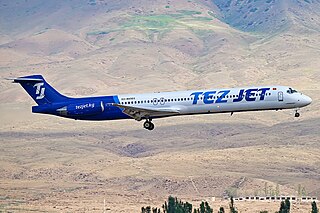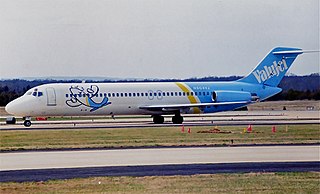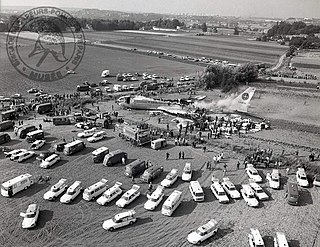
The McDonnell Douglas DC-10 is an American trijet wide-body aircraft manufactured by McDonnell Douglas. The DC-10 was intended to succeed the DC-8 for long-range flights. It first flew on August 29, 1970; it was introduced on August 5, 1971, by American Airlines.

The McDonnell Douglas MD-80 is a series of five-abreast single-aisle airliners developed by McDonnell Douglas. It was produced by the developer company until August 1997 and then by Boeing Commercial Airplanes. The MD-80 was the second generation of the DC-9 family, originally designated as the DC-9-80 and later stylized as the DC-9 Super 80 . Stretched, enlarged wing and powered by higher bypass Pratt & Whitney JT8D-200 engines, the aircraft program was launched in October 1977. The MD-80 made its first flight on October 18, 1979, and was certified on August 25, 1980. The first airliner was delivered to launch customer Swissair on September 13, 1980, which introduced it into service on October 10, 1980.

ValuJet Airlines Flight 592 was a regularly scheduled flight from Miami to Atlanta. On May 11, 1996, the ValuJet Airlines McDonnell Douglas DC-9 operating the route crashed into the Everglades about 10 minutes after departing Miami as a result of a fire in the cargo compartment possibly caused by mislabeled and improperly stored hazardous cargo. All 110 people on board were killed. The airline already had a poor safety record before the crash, and the accident brought widespread attention to the airline's problems. ValuJet's fleet was grounded for several months after the accident. When operations resumed, the airline was unable to attract as many customers as it had before the accident. It acquired AirTran Airways in 1997, but the lingering damage to the ValuJet name led its executives to assume the AirTran name. It is the deadliest plane crash in Florida as of 2024.

Saudia Flight 163 was a scheduled Saudia passenger flight departing from Quaid-E-Azam Airport in Karachi, Pakistan, bound for Kandara Airport in Jeddah, Saudi Arabia, via Riyadh International Airport in Riyadh, Saudi Arabia, which caught fire after takeoff from Riyadh International Airport on 19 August 1980. Although the Lockheed L-1011-200 TriStar made a successful emergency landing at Riyadh, the flight crew failed to perform an emergency evacuation of the airplane, leading to the deaths of all 287 passengers and 14 crew on board the aircraft from smoke inhalation.

Air Canada Flight 797 was an international passenger flight operating from Dallas/Fort Worth International Airport to Montréal–Dorval International Airport, with an intermediate stop at Toronto Pearson International Airport.

South African Airways Flight 295 (SA295/SAA295) was a scheduled international passenger flight from Chiang Kai-shek International Airport, Taipei, Taiwan, to Jan Smuts International Airport, Johannesburg, South Africa, with a stopover in Plaisance Airport, Plaine Magnien, Mauritius. On 28 November 1987, the aircraft serving the flight, a Boeing 747-200 Combi named Helderberg, experienced a catastrophic in-flight fire in the cargo area, broke up in mid-air, and crashed into the Indian Ocean east of Mauritius, killing all 159 people on board. An extensive salvage operation was mounted to try to recover the aircraft's flight recorders, one of which was recovered from a depth of 4,900 metres (16,100 ft).

The 1985 Manchester Airport disaster occurred when British Airtours Flight 28M, an international passenger flight, was en-route from Manchester Airport to Corfu International Airport and caught fire on takeoff on 22 August, 1985. The accident resulted in 55 fatalities.

American Airlines Flight 96 (AA96/AAL96) was a regular domestic flight operated by American Airlines from Los Angeles to New York via Detroit and Buffalo. On June 12, 1972, the left rear cargo door of the McDonnell Douglas DC-10-10 operating the flight blew open and broke off en route between Detroit and Buffalo above Windsor, Ontario; the accident is thus sometimes referred to as the Windsor incident, although according to the NTSB it is an accident, not an incident.

American Airlines Flight 157, a Douglas DC-6, departed on November 29, 1949, from New York City bound for Mexico City with 46 passengers and crew. After one engine failed in mid-flight, a series of critical mistakes by the flight crew caused the pilot to lose control of the plane during the final approach to a routine stopover at Love Field in Dallas, Texas. The airliner slid off the runway and struck a parked airplane, a hangar, and a flight school before crashing into a business across from the airport. 26 passengers and two flight attendants died. The pilot, co-pilot, flight engineer, and 15 passengers survived.

Air France Flight 296Q was a chartered flight of a new Airbus A320-111 operated by Air Charter International for Air France. On 26 June 1988, the plane crashed while making a low pass over Mulhouse–Habsheim Airfield as part of the Habsheim Air Show. Most of the crash sequence, which occurred in front of several thousand spectators, was caught on video.

Varig Flight 820 was a flight of the Brazilian airline Varig that departed from Galeão International Airport in Rio de Janeiro, Brazil, on 11 July 1973, for Orly Airport, in Paris, France. The plane, a Boeing 707, registration PP-VJZ, made an emergency landing in onion fields about five kilometres from Orly Airport, due to smoke in the cabin from a fire in a lavatory. The fire caused 123 deaths; there were only 11 survivors . Relief Captain Antonio Fuzimoto was the pilot who handled the controls and landed the plane in the field.

Aircraft emergency oxygen systems or air masks are emergency equipment fitted to pressurized commercial aircraft, intended for use when the cabin pressurisation system has failed and the cabin altitude has climbed above a safe level. It consists of a number of individual yellow oxygen masks stored in compartments near passenger seats and near areas like lavatories and galleys, and an oxygen source, like a centralized gaseous cylinder or decentralized chemical oxygen generator.

United Air Lines Flight 608 was a Douglas DC-6 airliner, registration NC37510, on a scheduled passenger flight from Los Angeles to Chicago when it crashed at 12:29 pm on October 24, 1947 about 1.5 miles (2.4 km) southeast of Bryce Canyon Airport, Utah, United States. None of the five crew members and 47 passengers on board survived. It was the first crash of a DC-6, and at the time, it was the second-deadliest air crash in the United States, surpassed by Eastern Air Lines Flight 605 by only one fatality.

Nigeria Airways Flight 9805 was a cargo flight from King Abdulaziz International Airport in Jeddah to Mallam Aminu Kano International Airport in Kano, Nigeria. On 19 December 1994, the Boeing 707-3F9C flying the route suffered an in-flight fire and crashed into a marshland near Kiri Kasama, Hadejia LGA, Nigeria. One of the three crew members and both passengers died. The investigation determined that a heat generating substance was the probable cause.

Aeroflot Flight 2306 was a scheduled domestic passenger flight from Vorkuta to Moscow in the Soviet Union, with a stopover in Syktyvkar. The Tupolev Tu-134 operated by Aeroflot crashed on 2 July 1986 during an emergency landing after it departed Syktyvkar, killing 54 of 92 passengers and crew on board.

Aero Flight 217 was a domestic passenger flight from Helsinki, Finland, to Mariehamn in the autonomous territory of Åland, operated by the Finnish flag carrier Aero O/Y. On 8 November 1963, the aircraft serving the flight crashed in poor visibility while attempting to land on a non-precision approach at Mariehamn Airport in the municipality of Jomala, resulting in the deaths of 22 people out of 25 on board. The crash remains the second most deadly aviation accident in Finland, the first being Aero Flight 311 almost two years earlier.

Delta Air Lines Flight 1288 was a regularly scheduled flight from Pensacola, Florida to Atlanta, Georgia. On July 6, 1996, the aircraft serving the flight, a McDonnell Douglas MD-88, was on takeoff roll from Runway 17 at Pensacola when it experienced an uncontained, catastrophic turbine engine failure that caused debris from the front compressor hub of the left engine to penetrate the left aft fuselage. The cause of the engine failure was found to have been a fault in the manufacture of the fan. The failure of the airline to spot the resulting crack in the blade was a contributing factor.

On 29 July 2011, EgyptAir Flight 667, a Boeing 777 on a scheduled passenger flight from Cairo, Egypt, to Jeddah, Saudi Arabia, suffered a cockpit fire on the ground at Cairo Airport, while preparing to depart. There were no fatalities, but seven people were treated for smoke inhalation. The aircraft was damaged beyond economic repair.

Federal Express Flight 1406 was an American domestic cargo flight from Memphis International Airport, Memphis, Tennessee, to Logan International Airport in Boston, Massachusetts, that suffered an in-flight cargo fire over New York on September 5, 1996. The three crew members and two passengers on board successfully evacuated after an emergency landing at Stewart International Airport in Newburgh, New York. After the evacuation, the DC-10 was consumed by fire. After an extensive investigation, the National Transportation Safety Board was unable to determine what caused the fire. Nevertheless, the Federal Aviation Administration made recommendations to prevent similar incidents from occurring in the future.

RED Air Flight 203 (L5203/REA203) was a scheduled international commercial passenger flight from Santo Domingo in the Dominican Republic to Miami International Airport by RED Air. On 21 June 2022, the McDonnell Douglas MD-82 aircraft operating the service suffered a left landing gear collapse and runway excursion, causing the left wing of the aircraft to impact an antenna structure, followed by a subsequent fire on the right side of the airplane. The incident caused three people to be hospitalized with minor injuries.




















